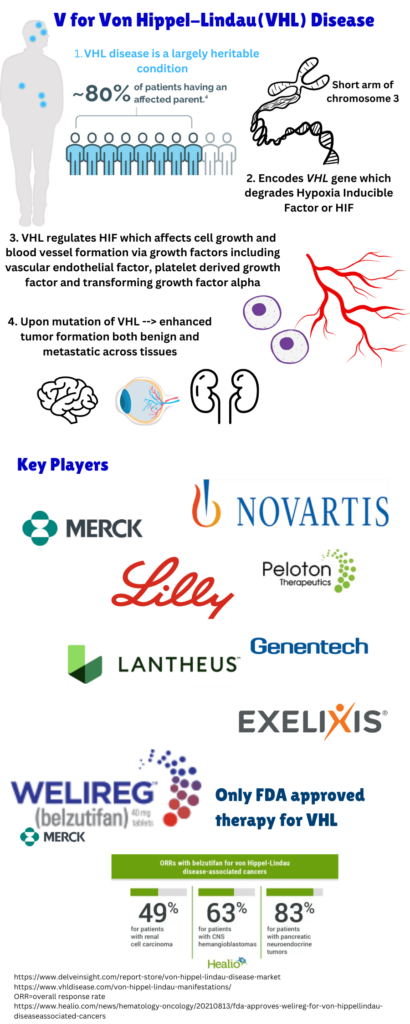Von Hippel-Lindau (VHL) disease is a rare, autosomal dominant genetic disorder caused by mutations in the VHL gene, a critical tumor suppressor gene. The VHL gene regulates the hypoxia-inducible factor (HIF) complex, which controls the production of growth factors like vascular endothelial growth factor (VEGF). Mutations in VHL disrupt this regulation, leading to increased growth factors that promote abnormal blood vessel formation and tumor growth.
Clinical Description, classification and symptoms
| Classification Level | Disorder |
| Prevalence | 1-9 / 100 000 |
| Age of Onset | Childhood, Adolescent, Adult |
| Inheritance | Autosomal Dominant |
Von Hippel-Lindau (VHL) disease increases the risk of developing tumors and cysts in multiple organs, including the brain, spinal cord, eyes, kidneys, pancreas, adrenal glands, liver, lungs, and reproductive tract. Hemangioblastomas, benign blood vessel tumors, are common and can cause symptoms like headaches, balance problems, and vision issues depending on their location. Pheochromocytomas, adrenal gland tumors, can lead to high blood pressure, panic attacks, and sweating. Renal cell carcinoma (RCC) often develops without early symptoms, but can cause back pain, blood in the urine, and fatigue. Pancreatic cysts and tumors may cause digestive discomfort, while reproductive tract tumors can cause infertility. Endolymphatic sac tumors in the inner ear may result in hearing loss and balance problems. Although liver and lung tumors are typically asymptomatic, kidney cysts may cause issues if they grow large or affect kidney function.

Figure: Von Hippel-Lindau (VHL) disease, Image source: Malini Gupta
Diagnosis and Treatment
VHL disease is inherited in an autosomal dominant manner, meaning that individuals with a mutated VHL gene have a 50% chance of passing it on to their children. Approximately 20% of VHL cases occur due to spontaneous mutations without a family history. The disease can vary in severity, with some individuals experiencing only mild symptoms while others face significant health issues. Diagnosis involves identifying specific tumors (like retinal or central nervous system hemangioblastomas, pheochromocytomas, and RCC) and confirming the presence of a VHL gene mutation. Regular surveillance, including MRI scans and ophthalmology exams, is essential for early tumor detection and managing potential complications.
Treatment for VHL is highly individualized and depends on the type, location, and size of tumors. The primary goal is to manage symptoms, monitor tumor growth, and prevent complications.
1. Surgical Intervention: Surgery is the primary treatment for VHL-related tumors. Hemangioblastomas in the brain or spinal cord are typically removed when they cause symptoms. Kidney tumors are often treated with kidney-sparing surgery when they reach 3 cm in size or show rapid growth, helping to preserve kidney function. Pancreatic tumors are usually monitored, and surgery is considered if a pancreatic neuroendocrine tumor grows or becomes symptomatic. Endolymphatic sac tumors causing hearing loss or balance issues are surgically removed to prevent further complications.
2. Targeted Therapies: In 2021, the FDA approved belzutifan (Welireg) for treating VHL-related tumors, including renal cell carcinoma, central nervous system hemangioblastomas, and pancreatic neuroendocrine tumors that do not require immediate surgery. Belzutifan works by inhibiting the HIF pathway, which is dysregulated in VHL disease and contributes to tumor growth. This drug offers an alternative for patients who cannot undergo surgery, although surgery remains the standard treatment for most patients. In 2023, the FDA expanded the approval to include advanced RCC in patients previously treated with PD-1/PD-L1 inhibitors and VEGF-TKI drugs.
3. Radiotherapy: Stereotactic radiosurgery may be considered for small, asymptomatic hemangioblastomas as a preventative measure, though its long-term benefits remain uncertain. Surgery is often preferred in these cases.
4. Regular Monitoring and Surveillance: Ongoing surveillance is critical for VHL patients. MRI scans monitor brain, spinal cord, and kidney tumors, while ophthalmology exams help detect retinal hemangioblastomas. Blood pressure and urine tests are used to monitor pheochromocytomas. Early detection of tumors allows for timely intervention, reducing the risk of severe complications.
5. Symptom Management: Managing symptoms is crucial, particularly for issues caused by pheochromocytomas, such as high blood pressure, and for alleviating pain from tumors. If kidney function is compromised, appropriate kidney health management is also important.
Regular monitoring and early intervention are key to improving the quality of life and outcomes for those with VHL disease. With a compound annual growth rate (CAGR) of 6.92%, the Von Hippel-Lindau (VHL) illness market is expected to reach $501.24 million by 2031 from an anticipated $293.47 million in 2023.
For more on rare diseases, stay tuned for next installment of Care for Rare. Meanwhile, click here for more available resources and support groups for Von Hippel Lindau Disease.
Sources
- https://www.vhldisease.com/
- https://rarediseases.org/rare-diseases/von-hippel-lindau-disease/
- https://www.orpha.net/en/disease/detail/892
- https://www.healio.com/news/hematology-oncology/20210813/fda-approves-welireg-for-von-hippellindau-diseaseassociated-cancers
- https://www.delveinsight.com/report-store/von-hippel-lindau-disease-market
- https://www.welireg.com/von-hippel-lindau/treatment-resources/
– Malini Gupta, Ph.D.
Disclaimer
The editors take care to share authentic information. In case of any discrepancies please write to newsletter@medness.org
The sponsors do not have any influence on the nature or kind of the news/analysis reported in MedNess. The views and opinions expressed in this article are those of the authors and do not necessarily reflect the official policy or position of MedNess. Examples of analysis performed within this article are only examples. They should not be utilized in real-world analytic products as they are based only on very limited and dated open-source information. Assumptions made within the analysis are not reflective of the position of anyone volunteering or working for MedNess. This blog is strictly for news and information. It does not provide medical advice, diagnosis or treatment nor investment suggestions. This content is not intended to be a substitute for professional medical advice, diagnosis, or treatment. Always seek the advice of your physician or another qualified health provider with any questions you may have regarding a medical condition. Never disregard professional medical advice or delay in seeking it because of something you have read on this website.
MedNess is a part of STEMPeers® which is a 501(c)(3) organization registered in PA as PhD Career Support Group. The organization helps create a growing network of STEM scientists that is involved in peer-to-peer mentoring and support.



